Ferdinand Bain’s Rancho La Lomita
The youngest son of middle-class hotel operators, on his own at 18, Ferdinand Bain found success in railroads, utilities, real estate, and farming. He made his fortune in Poughkeepsie, New York, and built on it in Los Angeles. His Rancho La Lomita, the premier Jersey ranch on the Pacific Coast, would last only 20 years, and his name is forgotten by most. But the big house he built on the little hill has stood the test of time; nearly a movie set, it is now the heart of a Westside educational institution.
Ferdinand’s “Back Story”
Ferdinand Randall Bain (1861-1945) was born in Chatham, New York. In 1878, his family arrived in Poughkeepsie, Dutchess County, New York, to manage the Poughkeepsie Hotel, following previous stints managing hotels in Chatham, Brewster, and Dover Plains, New York. Bain helped his father and his brother, Horatio (1857-1918), run the hotel. Their eldest brother, Francis N. Bain, was connected with the hotels, while also operating two farms in eastern Dutchess County, New York, where Francis bred “high-class road and carriage horses.” The Bains’ father, Milton (1826-1880), had been county assessor and a deputy sheriff. Both parents died soon after Ferdinand completed his secondary education at various schools, so he gave up his college plans.
In 1885, at age 24, after hotel clerking in the shadow of his brothers’ growing success, Ferdinand left the hotel business to make his own mark on Poughkeepsie. (Horatio had expanded to operating not only the Poughkeepsie Hotel, but also the Nelson House in Poughkeepsie and the Palatine Hotel in Newburgh). He opened F. R. Bain and Company, an insurance, investment securities and real estate brokerage firm. That year, he also married Harriett “Hattie” I. Kenworthy (1863-1938), a daughter of Richard Kenworthy (1823-1888), former Dutchess County sheriff and treasurer of the Hudson River State Hospital. Bain’s only three children were born to this union: Ethel M. (1887-?), Mary Kenworthy (1890-1971), and Catherine F. (1893-?) Bain.
In 1888, the Bains bought a lot on Montgomery Street on the edge of the fashionable Garfield Place – Academy Street neighborhood. This affluent enclave of handsome Victorian homes was within easy walking distance of Poughkeepsie’s commercial hub on Market Street, where both Bain’s office and his family’s hotel business were located. To design his home, Bain selected architect Arnout Cannon (1839-1898), one of Poughkeepsie’s most prominent late 19th century architects, practicing residential, school, church, and commercial architecture throughout the Hudson Valley. The house he built for the Bains, at 57 Montgomery Street, was listed on the National Register of Historic Places in 2016 and recognized with the 2022 New York State Historic Preservation Award for Excellence in Historic Building Rehabilitation.
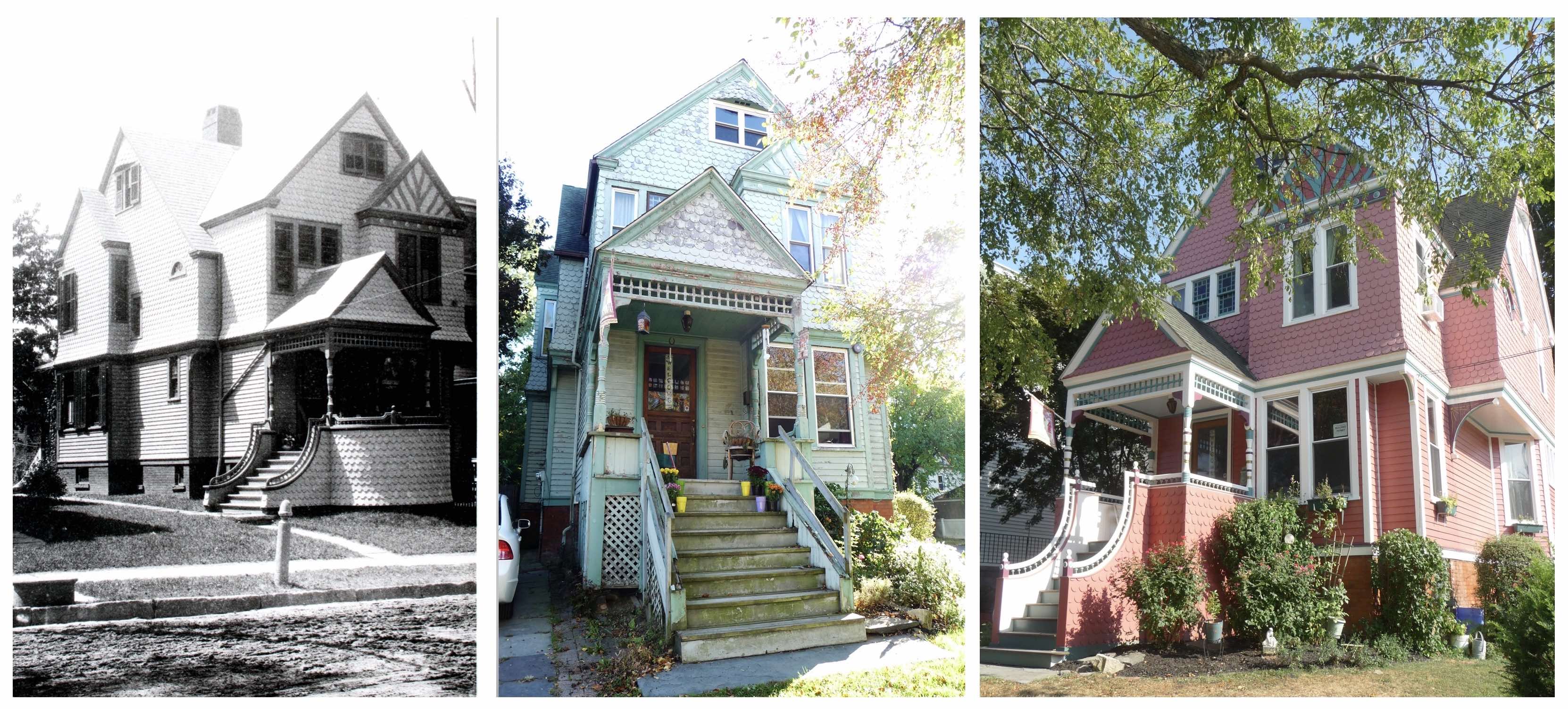
Bain began his business career in partnership with Edmund Young – a wise choice of partners indeed, for Poughkeepsie had long benefited from the independently wealthy and civic minded Young family, who had settled in Poughkeepsie in 1853 on the South Hamilton St. estate known as “Cedarwood.” The Youngs were leading investors in two of the city’s key public utilities, the horse car street railway and the gas lighting industry. Modernizing and improving these key public utilities was crucial to Bain’s work as a real estate broker and real estate buyer keen on developing new Poughkeepsie neighborhoods throughout the 1890s. Bain also built political clout, getting himself twice elected to city council (in 1886 and in 1888) and to a county supervisor seat in 1890. In 1894, Bain was appointed to the position of city assessor. These positions helped advance Bain’s real estate goals. For example, in the public transportation industry, city council members (aldermen) held power of approval over expanding and electrifying the city’s streetcar system into areas of the city where Bain planned to develop new housing.
In 1890, Bain blended wealthy backers and political clout. With the support of the Young family, Bain and other members of the old horse car street railway syndicate created a new “South Avenue Surface Railway Company” to provide an electric street car line from Main and Market streets along South Avenue to the Poughkeepsie Rural Cemetery. Five months later, at what was considered one of the most important real estate auctions in the city’s history, Bain acquired the 75-acre parcel (informally known as “Livingston Woods”) adjacent to the proposed new South Avenue trolley line using financial backing from a six-man syndicate. Under his management and on his suggestion, the Vassar College and Driving Park line, and the Wappinger Falls line were added to the rail enterprise.
In 1892, Bain pressed on with clearing the land for development along the Poughkeepsie railway. The Poughkeepsie News-Telegraph noted the daring nature of the entire Bain enterprise, commenting: “probably no other man in the city would care to undertake the improvement of 75 acres of farm and woodland in this neighborhood on the lines of real estate speculation. But Mr. Bain is indefatigable.” Over the next decade, Bain added to his holdings along the new South Avenue trolley line by acquiring and subdividing. When appointed city assessor in 1896, Bain seized his chance to place higher valuations on city property. A public outcry resulted.
To the amazement of the assessment grievance board, Judge Joseph Barnard (1823-1904) who was normally charged with hearing assessment disputes) stepped forward to complain about his own assessment, particularly the lands at the rear of his property on Academy Street, which bordered Bain’s electric streetcar railway along South Avenue. After the judge finished his statement, Bain jumped up and followed him out of the room, asking the judge if he would sell the land along South Avenue at the low price the judge claimed it was worth. As the papers later gleefully described the scene, “The judge said he meant his words and Mr. Bain purchased the property at once.” During his years in real estate, Bain platted and opened up several important additions, among them Bain Avenue, Taylor Avenue, and a portion of North Hamilton Street.
Far from Poughkeepsie, Bain was vice-president and active manager of the West Coast Steam Line, running from Port Tampa to St. Petersburg, which he made profitable.
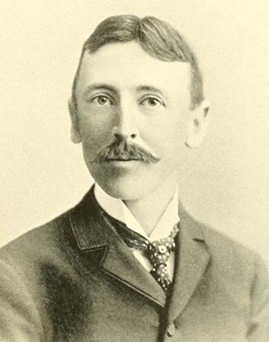
After selling his interest in the Poughkeepsie street railway, Mr. Bain worked with Thaddeus Beal, William R. Beal, and John Wilkie in putting together the deals that acquired and combined Newburgh and Poughkeepsie electric and gas. First in Newburgh in 1900 and then a year later in Poughkeepsie in 1901, Bain was instrumental in pulling together the investors and experienced managers capable of successfully consolidating the gas industry with the electric industry. Bain served as the first president of both the new Newburgh Light, Heat and Power Company and the new Poughkeepsie Light, Heat and Power Company – companies which would merge to form Central Hudson Gas and Electric. In facilitating the merger, Bain became associated with Benjamin Barker Odell, Jr. (1854-1926), who had served as New York’s governor from 1901-1904.
Along with being a leading figure in railroad and public utility circles in New York state, Bain was also a director of the Farmer’s and Manufacturer’s National Bank of Poughkeepsie and president of the Varick Realty Company, owners of a square block of property in the heart of New York City’s business district. Foreshadowing his future as a gentleman farmer, Ferdinand Bain was secretary of the Dutchess County Agricultural Society for fourteen years.
After 1904, Mr. Bain disposed of most of his Poughkeepsie holdings, except his interest in the Gas Company and the bank, and had his headquarters in New York City, at 35 Wall Street. Bain had sold the 57 Montgomery Street in 1899.
From around 1904 until divorcing Hattie in about 1911, Bain was out of active touch with business affairs, and spent most of the time traveling. Upon marrying Gertrude C. Benchley (1854-1916) in New York City in 1911, Mr. Bain began a new life in California. Bain had visited Southern California on a business trip in 1910, during which he became intrigued with the possibility of consolidating its gas companies. Returning the following year, in February 1911, Bain organized a syndicate to purchase several artificial gas plants in Whittier, Monrovia, Covina, and Orange County.
Mr. Bain took over the gas plants and business at Fullerton, Anaheim, Orange, and Santa Ana and began improvements. He furnished the capital and gave the business the benefit of his experience. On June 1, 1912, when Southern Counties Gas Company started, it served 6 communities. In 1915, Southern Counties was among the first in the West to convert to natural gas. In 1916, Bain purchased Southern California Edison’s gas properties in several cities, more than doubling his company’s holdings. (L. A. Times, Jan. 20, 1916.) He was also widowed that year, when Gertrude died in Santa Barbara.
In 1917, he acquired the Upland-Ontario Gas Company’s plant and later facilities in Ventura and Santa Barbara. By 1921, Southern Counties Gas provided natural gas to more than 70,000 consumers in five counties.
Rancho La Lomita
During his first years in Southern California, Ferdinand Bain searched for property on which to build a country home and raise purebred livestock. In 1919, Bain bought about 90 acres just outside the City of Los Angeles’ western limits “that was easily accessible to the city, one with scenic attractions, one situated in a fertile spot where he could grow things and have ideal farming conditions, and one with a good water supply” for his Rancho La Lomita (“Little Hill Ranch”). (Making a “Country Estate” in the Suburbs Pay for Itself (L. A. Times, July 18, 1920).)
Along the property’s northern edge, Pacific Electric Railway Company operated the Santa Monica Air Line, a “Red Car” line carrying freight and passengers between central Los Angeles and Santa Monica. (Today, that strip carries Los Angeles Metro’s E Line (formerly Expo Line).) John D. Young (1843-1915) (unrelated to the Poughkeepsie Youngs) had subdivided his part of the former Rancho La Ballona into 19 parcels in November 1875 a month after the Air Line’s predecessor – the steam-powered Los Angeles & Independence Railroad – began running across his land. Mr. Bain essentially bought lots 5-8 (shown below), though Elenda Young had subdivided lots 6-8 in 1888.
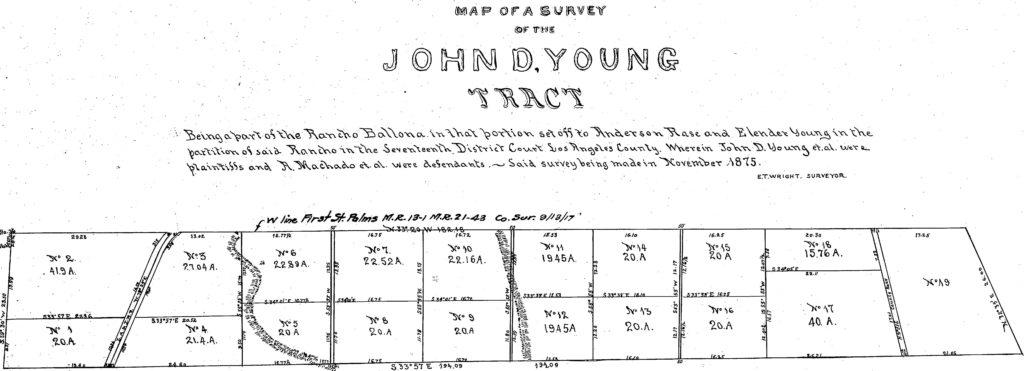
Though he remained at the helm of Southern Counties Gas until his death in Los Angeles on August 13, 1945 (at age 85), Bain took farming seriously. He filled the ranch with livestock — hogs, chickens, sheep, cattle and turkeys representing some of the finest bloodlines in the United States and Europe. The fields produced corn and alfalfa. Bain was known to invite friends to dinner and, at its conclusion, open the dining room French doors so his guests could admire his prize cattle as his men drove them by.
In 1920, the Los Angeles Times reported that Bain had “developed a breeding establishment that ranks among the best in the country” and that his herd of pure-breds “offers convincing evidence of his faith in [the] Channel Island breed, while the popular blood lines he has incorporated in his breeding reflect his unceasing effort to build up a herd of sterling worth not only as to production but as to outstanding breed type.” (Making a “Country Estate” in the Suburbs Pay for Itself (L. A. Times, July 18, 1920).)
In 1924, as president of the California Jersey Cattle Club, Ferdinand Bain hosted a two-day jubilee and cattle ranch tour – starting at Rancho La Lomita. (L. A. Evening Express, Oct. 21, 1924.)
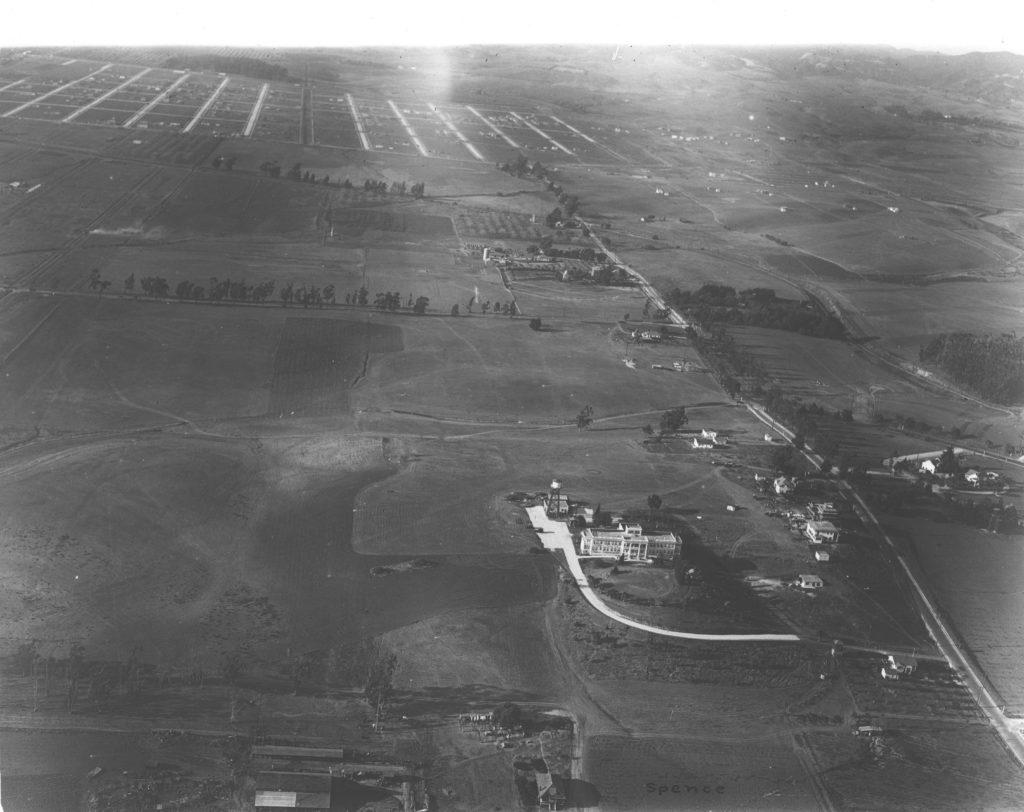
Atop the Overland Hill (indicated by the partial circle on the John D. Young tract map above) Bain built a red brick Colonial Revival home surrounded by ornamental trees and formal gardens. Bain’s Rancho La Lomita house was designed by Marston, Van Pelt, & Maybury, who have several works listed on the U.S. National Register of Historic Places. Architectural Digest featured the house in 1925. Incidentally, Bain’s Southern Counties Gas Company headquarters, another Colonial Revival building designed by Walker and Eisen opened in 1923 and is itself on the National Register of Historic Places.
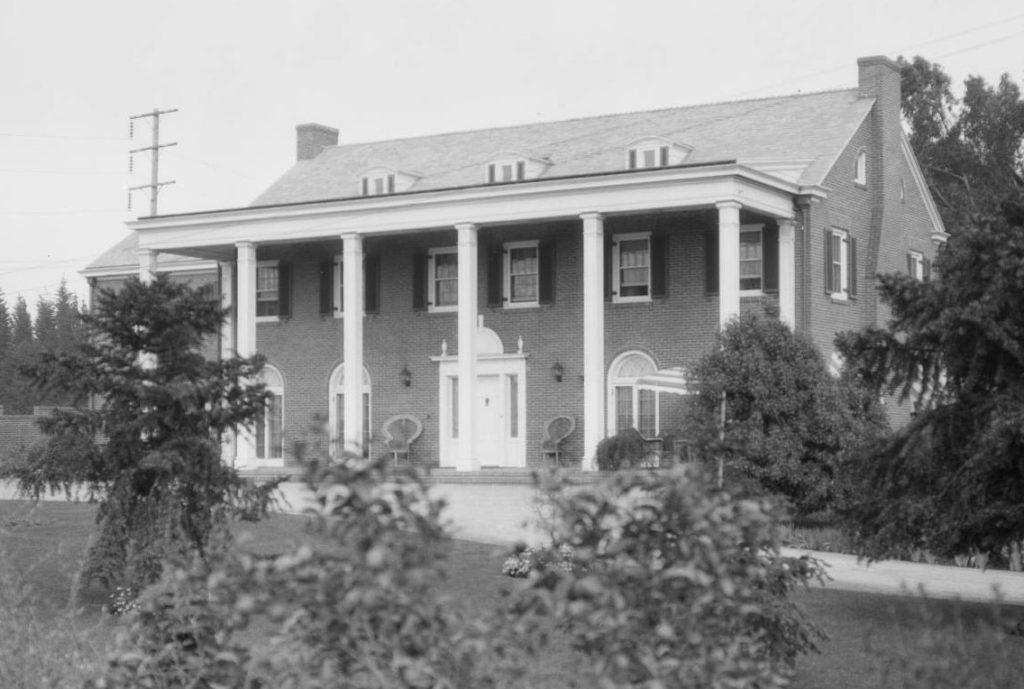
Ferdinand Randall Bain married Elizabeth “Bess” S. Fisher (1876-1959) in San Francisco, California in 1925. At the time, he was president of the Lomita Gasoline Company and a director of the National City Bank of Los Angeles, the Santa Monica Home Telephone Company, and the Sierra Bond and Mortgages Company of Santa Monica. His clubs included the California Club, Edgewater Club of Santa Monica, Santa Barbara Country Club, Downtown Club of New York and Midday Club of Chicago.
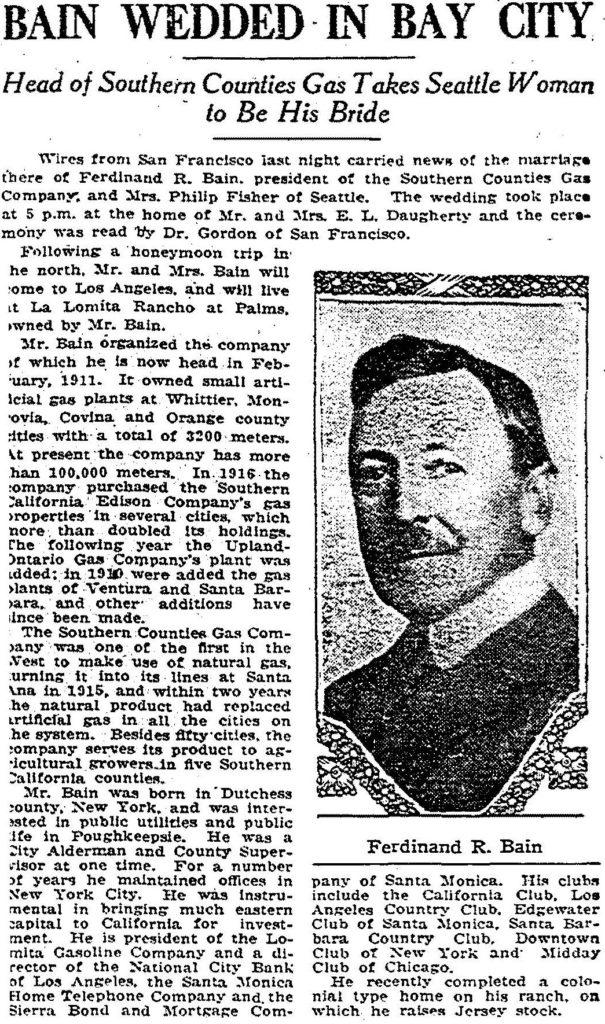
In Fall 1925, Mr. Bain had nearly 300 head of dairy cattle, many of which he had personally selected on his trips to Europe and to the Isle of Jersey. La Lomita repeatedly took home ribbons and grand championships. In a full-page Los Angeles Times advertisement, Bain bragged “On the 1925 show circuit our herd won 101 blue ribbons and 30 championships including 12 grand championships or every ‘grand’ at Stockton, Sacramento, Ventura, Pomona, Riverside and Watsonville.” (L.A. Times, Nov. 15, 1925.)
In 1926, an industry publication reported that Rancho La Lomita is “one of the model dairy ranches in this state. Milk from the ranch is all Government tested and is sent direct to many of the fashionable hotels and clubs in this section among which are the Biltmore Hotel, Alexandria Hotel, L. A. Country Club, and the Hollywood Athletic Club.” (Farm and Ranch Market Journal (Los Angeles), Premier Jersey Herd of Pacific Coast at Palms (Sept. 9, 1926), p. 2.)
Bain’s business was not for those with light wallets. “One of the leading sires of the herd at Palms, is Oxford Majesty’s sybil Gipsey, conceded to be one of the Greatest sons of Sybil Gamboge” “a bull who sold for $65,000” in 1919 (over $1 million in 2020 dollars). (L.A. Times, Our Sybil Family, La Lomita Rancho, Registered Jersey Cattle (Aug. 1, 1926).)
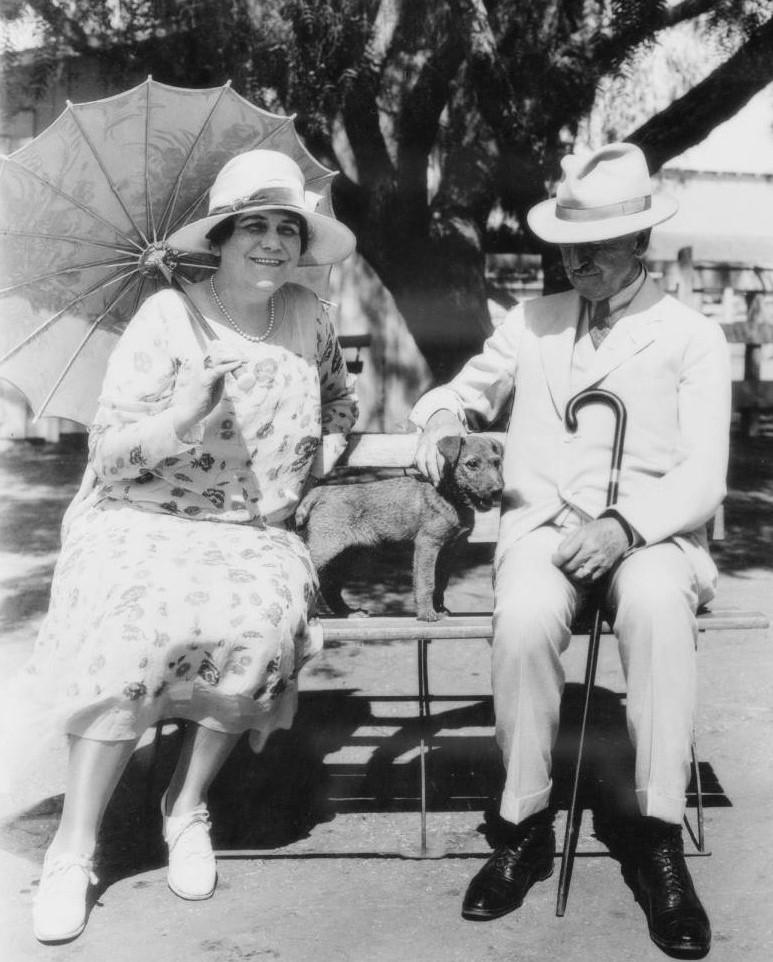

In 1927, Ferdinand Bain established another Rancho La Lomita – this one near Lockeford, California, in San Joaquin County. “‘La Lomita Rancho,’ a 392-acre property, was purchased by Ferdinand R. Bain, owner of a ranch by the same name at Palms, California, which is stocked with more than 200 head of fine Jersey cattle, including a recent importation of 19 head direct from Jersey island.” “Bain purchased the Mossdale property from the Mossdale Farms company a short time ago . . ..” (La Lomita Rancho with Jersey Herd will be One of Show Places of County, Stockton Independent, Oct. 23, 1927).) That same article reported that Bain’s original Rancho La Lomita was a “120-acre tract” (rather than 90), so he might have bought or leased additional land north of the railroad tracks at the Los Angeles local. The paper also reported in glowing terms on the workers’ conditions: “A large staff of employees under Alex M. Wilson, manager of ‘La Lomita’ at Palms is furnished with the best of housing facilities and are supplied with their own social rooms in which they enjoy the privileges of an exclusive club.”
Earlier in 1927, on March 24, the original Rancho La Lomita became part of the City of Los Angeles, with the Mar Vista Addition annexing the area.
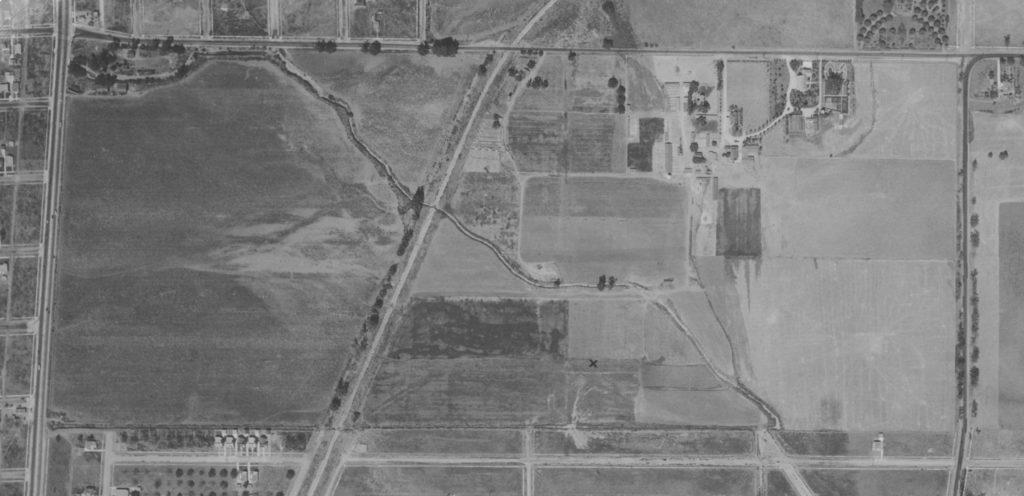
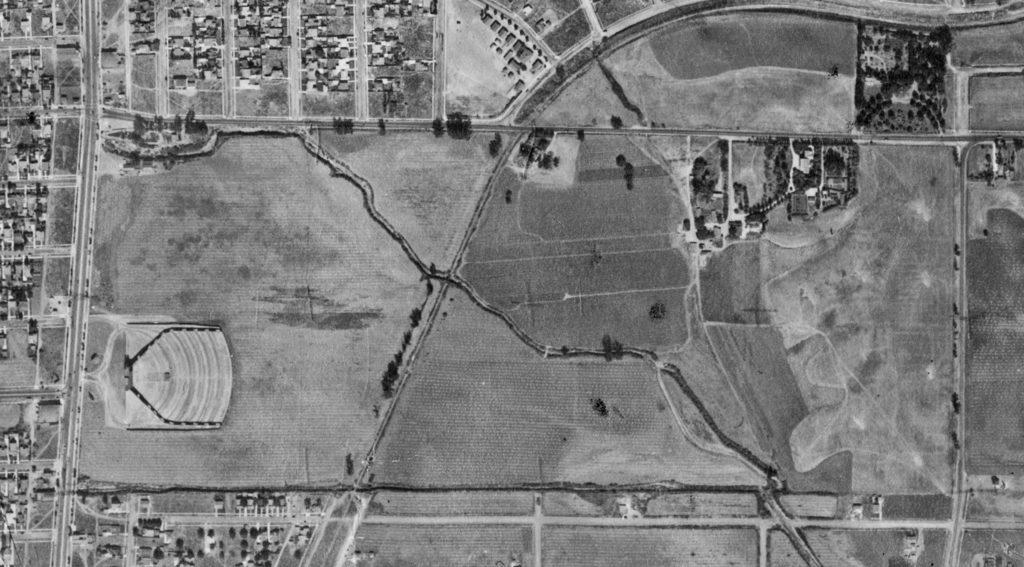
The Great Depression affected Bain as it did many others. During the early-1930’s he leased portions of the fields, reserving for himself only the five acres surrounding the house. This action, however, was not sufficient. In Fall 1934, Bain signed a trust deed and later a note to secure a loan of $436,817 with Rancho La Lomita as security. Four years later, in 1938 the bank foreclosed, and a written Declaration of Default and Demand for Sale was issued. On February 24, 1939, Rancho La Lomita became the property of the Security First National Bank. The banks’ archives contain several pictures of the estate in March 1939.

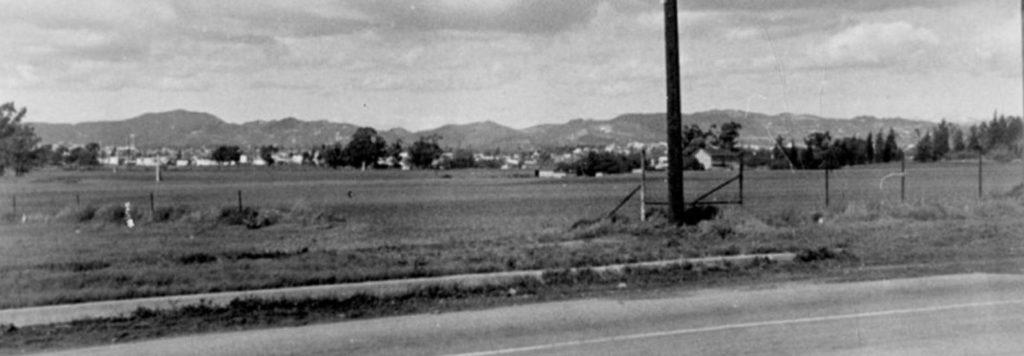
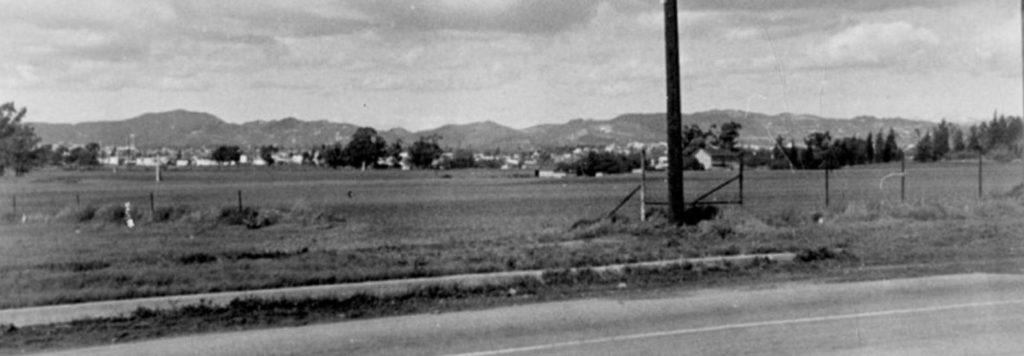
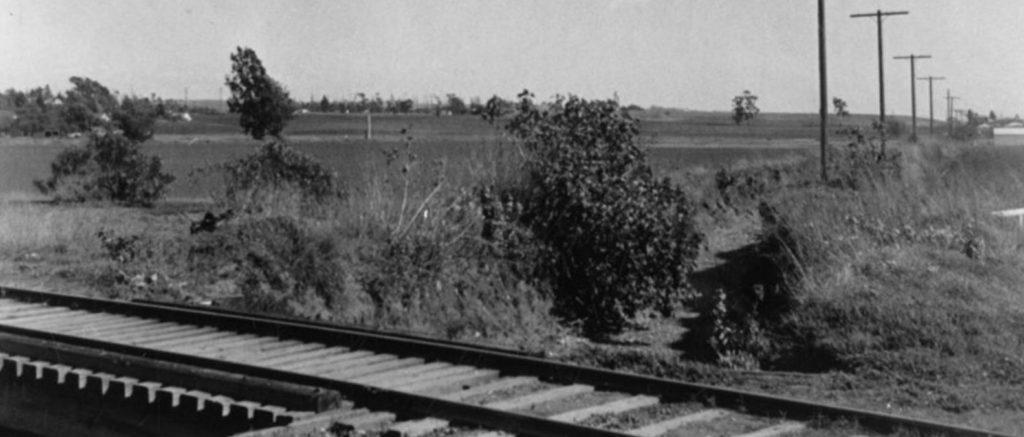
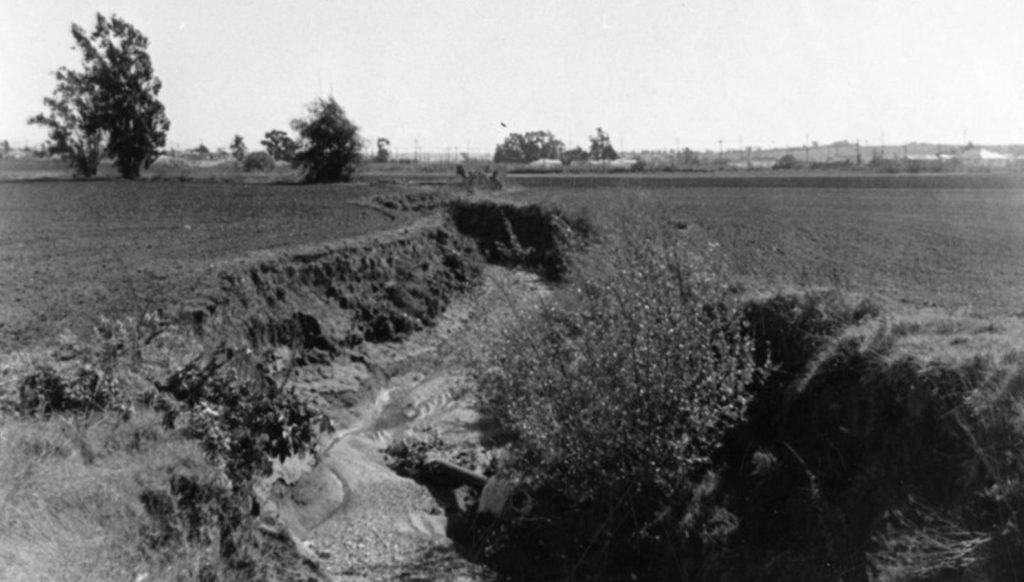
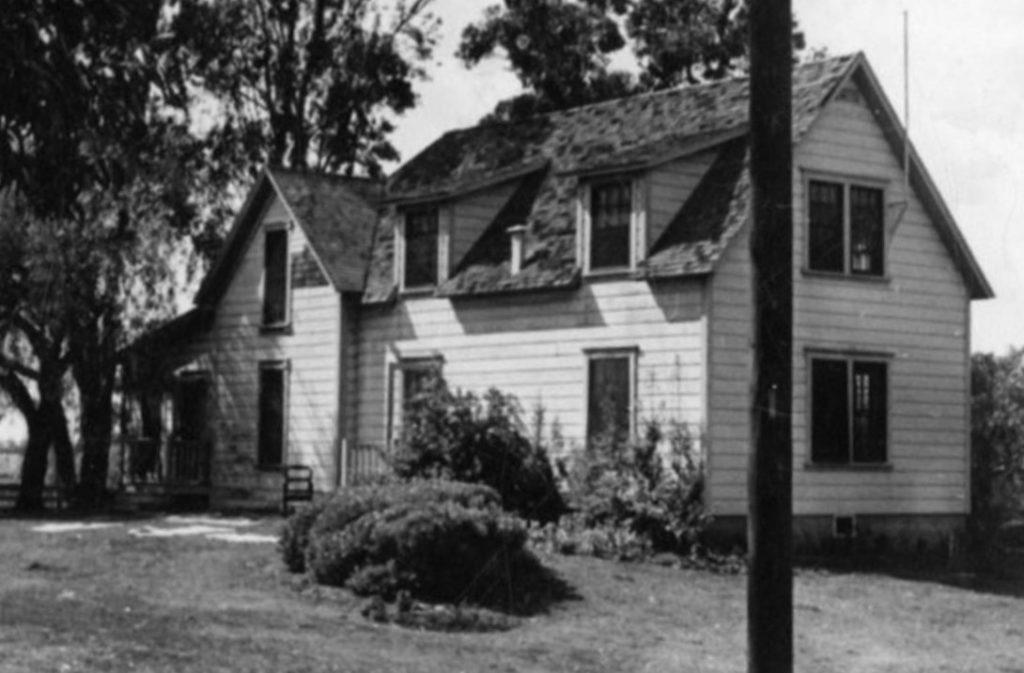
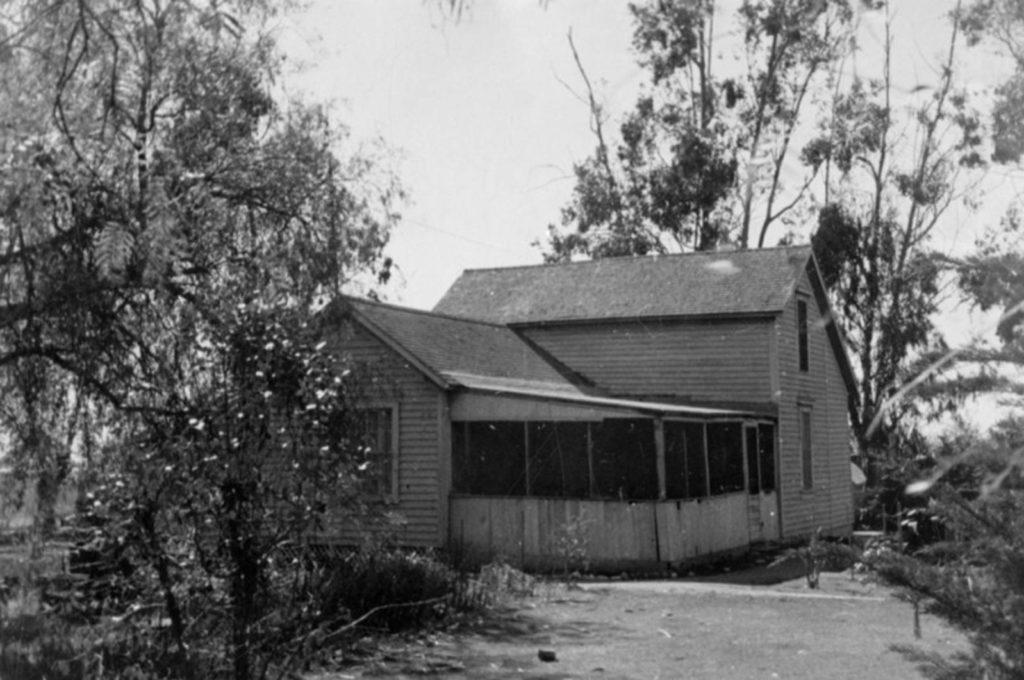
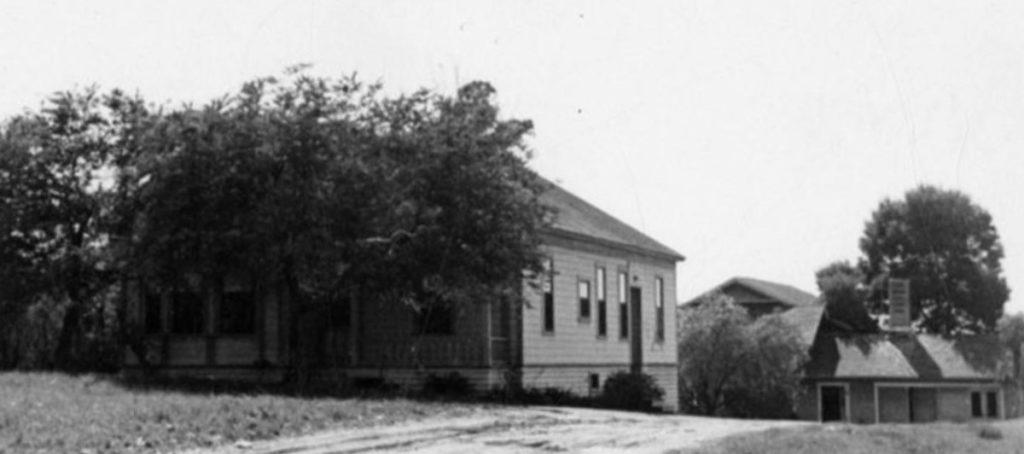
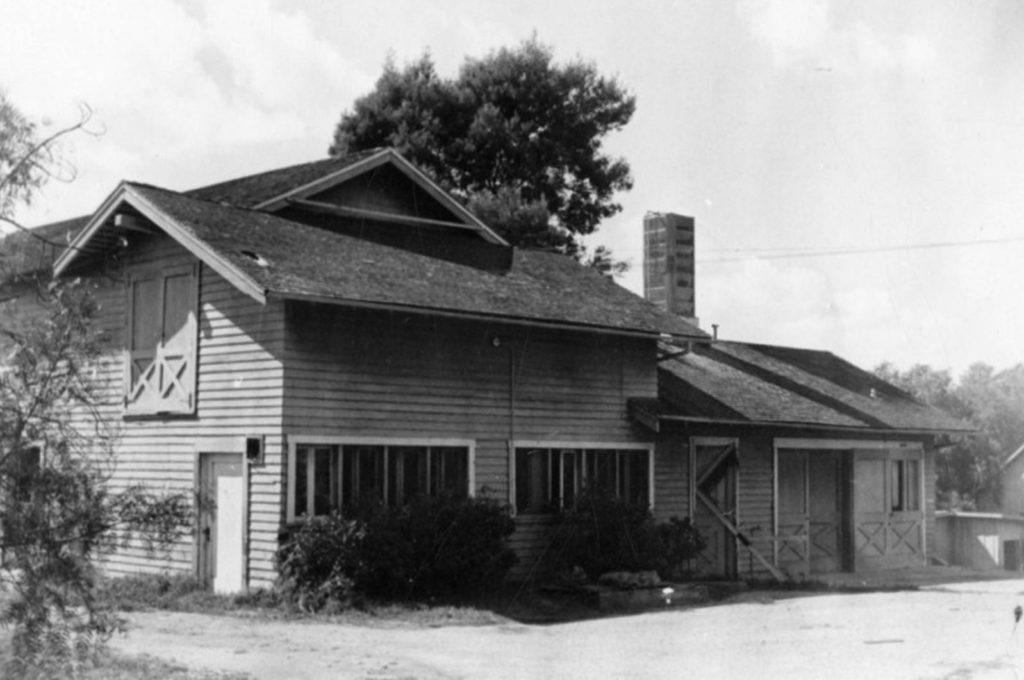
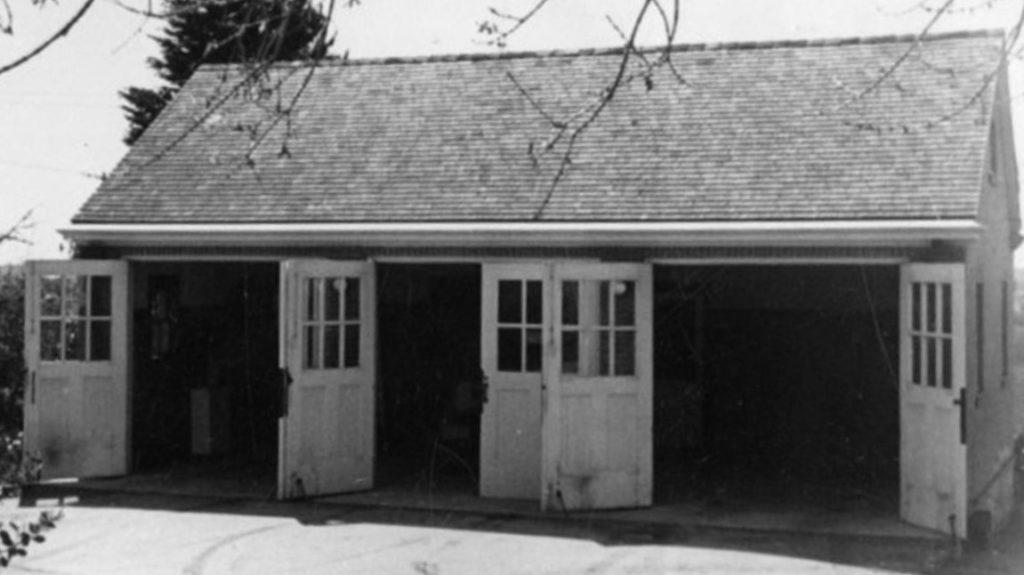
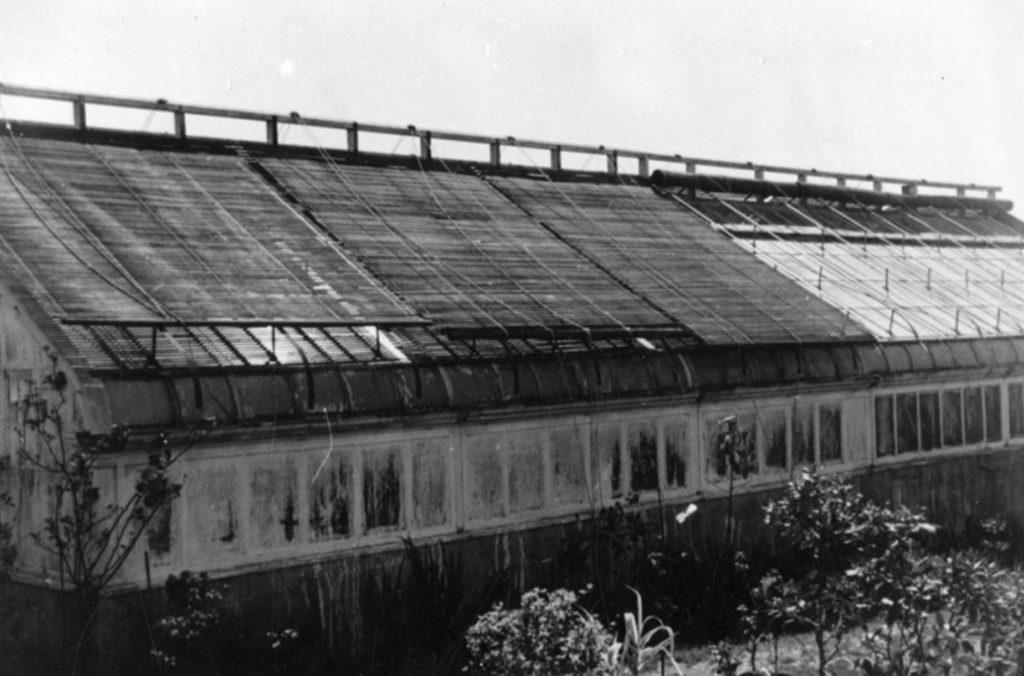
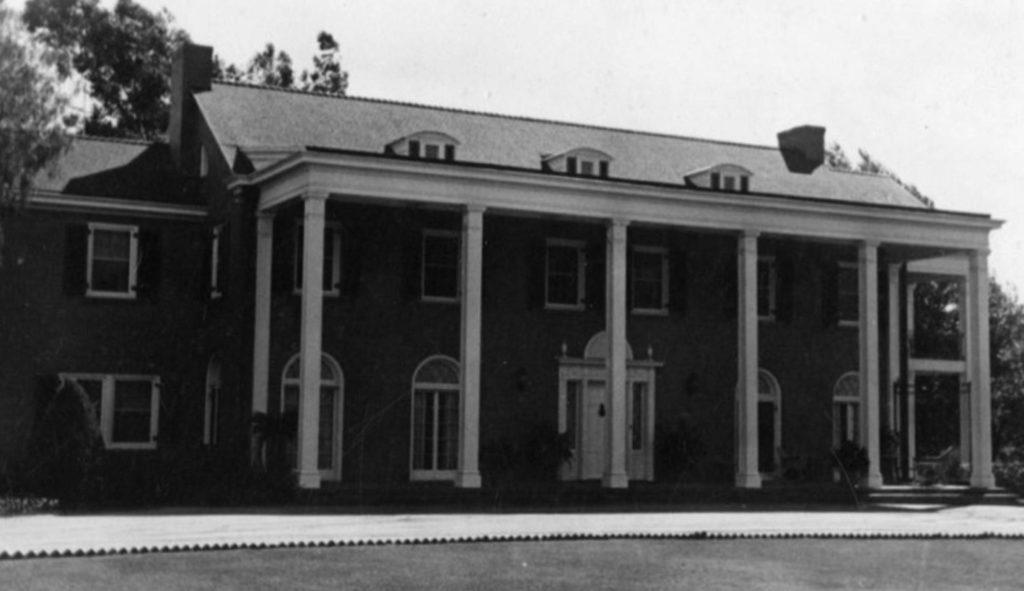
The bank considered the house an “over improvement,” suitable for a rest home or sanitarium. Coincidentally, at least until 1929, there was a sanitarium one hill down Overland (shown higher up on this page): the Porter Sanitarium, where Dr. Charles Sanford Porter (1862-1941) was a well-known advocate of the “milk diet treatment.” Subsequently operating as the Southern California Hospital, Porter’s building has held Le Lycée Français de Los Angeles, a private French school, since 1967. (Le Lycee Francais Acquires Building for Second Campus (L.A. Times, Sept. 24, 1967).)
Paramount City
Paramount Pictures stepped up to buy Rancho La Lomita in 1939, announcing worldwide its plans for a $12 million studio on the site. Paramount bought Rancho La Lomita’s 90 acres as well as Magdalena Wolfskill Sabichi’s (1846-1930) 60 acres north of the Southern Pacific tracks to Pico Boulevard for “Paramount City.” The 150-acre tract would be served by the Pacific Electric railway “delivering freight and passengers at Paramount City station from modern trains, where once the Spanish Dons rode to fiestas on horseback.” (Paramount City – New Studio Planned, The Age (Melbourne, Victoria, Australia), Aug. 11, 1939.) Nearby Clover Field airport, with the Douglas Aircraft Company’s headquarters and factory next door, were said to be planned for: “The problem of aircraft and other noises that might interfere with sound recording will be with complete soundproofing.” Paramount intended to repurpose Bain’s “mansion” as a “permanent set.” For a short time, Paramount leased the Bain house to the Consul General of Chile.
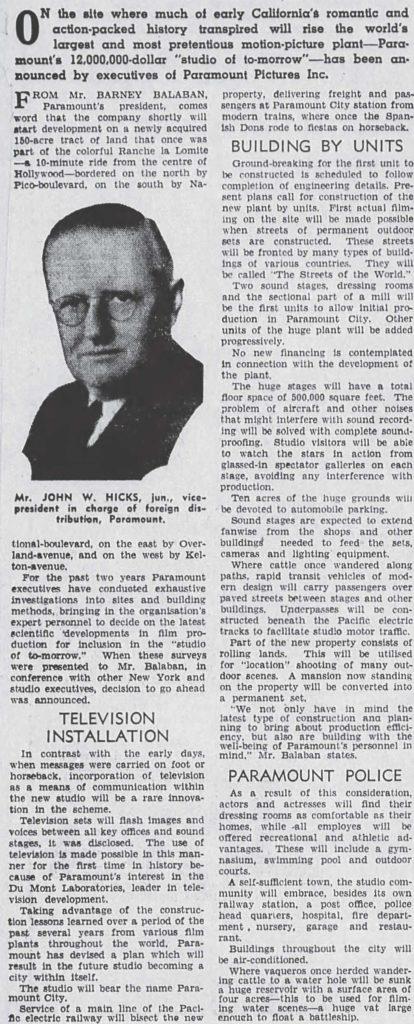
Paramount’s plans stalled with American entry into World War II and were reportedly stymied, in part, by airplane noise. Abandoning its plans, in 1944 Paramount sold most of the land to Overland Housing Company for defense worker houses in Rancho Park’s Westwood Gardens neighborhood. In 1945, it sold the 2 ½ acres the Bain house sat on to the Catholic Archdiocese for the Sisters of Notre Dame‘s schools. (The Archdiocese promptly bought additional space from the developers to expand the school.)
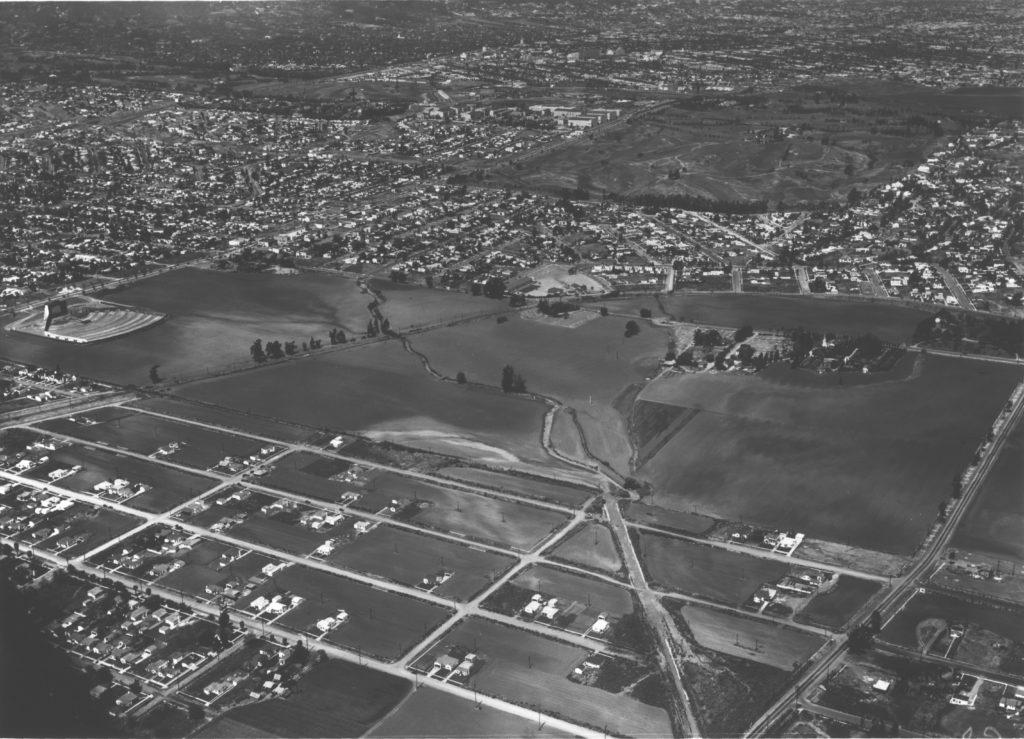
Rancho La Lomita is surrounded by residential development in the above picture. At top, left to right, are Westwood Hills, Country Club Highlands, and Cheviot Hills. At bottom, less developed, is Ambassador Park. Ambassador Park’s relative emptiness was reflected in the bank’s Inspection Report: “The district to the west, which compares with this low portion, has been subdivided and there is a little new construction there. However, sales of vacant lots have been slow. Lots there 50 x 125 are for sale at from $300 to $600. Unless the drainage problems are corrected, there will be very little interest in this section.” (Inspection Report, Security First National Bank, February 6, 1939.)
Notre Dame Academy
In Spring 1944, as Paramount was about to sell the Rancho to housing developers, the Sisters of Notre Dame were looking for a site to expand their educational operation (having staffed a school in Southern California since 1924). Archbishop John Joseph Cantwell (1874-1947) put them in touch with Father William T. O’Shea (1902-1963), pastor of nearby St. Timothy’s Catholic Church, which had been founded only a year before. Coincidentally, Father O’Shea had recently visited Archbishop Cantwell proposing to buy the Bain house and property for a school.
Mother Mary Vera, with Sisters Mary Fortunata and Mary Bernard, soon visited Father O’Shea at a one-room store (likely an ice cream parlor) on Pico Boulevard which held the church.
“As soon as Father learned the purpose of the sisters’ visit and read the Archbishop’s letter of introduction and wishes, he contacted Mr. Pierson, the real estate agent. Together they drove the three sisters up Overland Avenue to see the property.”
“When Mother Mary Vera returned [from Cleveland, in October], she proposed acquiring the Overland property for an elementary school.”
“In November seven additional lots [along Selby Avenue and Clarkson Road] became available. This would increase the total acreage on Overland to four which would be adequate for the sisters’ purposes.”
“Escrow closed on May 29 and on May 31 [1945] the four acres on the Overland Hill became the property of the Sisters of Notre Dame.”
Sisters of Notre Dame, Los Angeles, Notre Dame, unpublished (May 13, 1969)
With the help of City Councilmember Harold Harby (1894-1978) and Twentieth Century Fox Studios executive “Doc” Bishop (a former newspaper gossip columnist who discovered Shirley Temple), they got the necessary zoning changes. Notre Dame Elementary School officially opened in September 1946, and Notre Dame Academy, a four-year high school for girls, in Fall 1949. In Fall 1958, the Sisters of Notre Dame began leading St. Timothy School, adjacent to the church on Pico Boulevard.
Partial Bibliography
Several histories, published and unpublished, are referenced and many are linked above, including:
Commemorative Biographical Record of Dutchess County, New York (J. H. Beers & Co., Chicago, 1897)
John Steven McGroarty, Los Angeles from the Mountains to the Sea, With Selected Biography of Actors and Witnesses to the Period of Growth and Achievement, Volume 2 (1921)
Sisters of Notre Dame, Los Angeles, Notre Dame, unpublished (May 13, 1969)
Sister Mary Joanne Wittenburg, Two Men and Their Ranchos, unpublished (revised c. 2007)